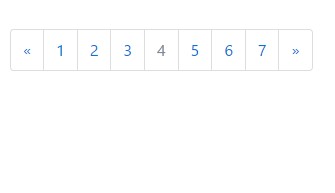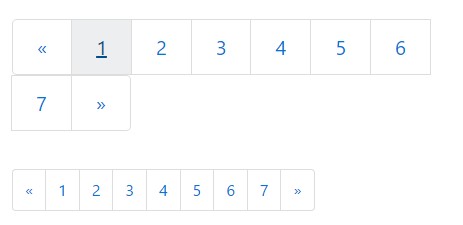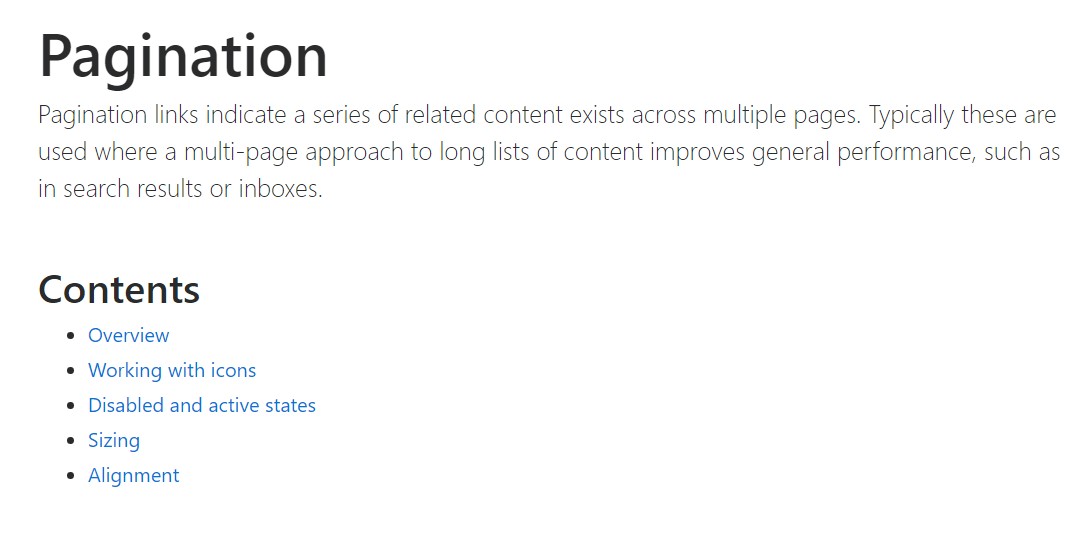Bootstrap Pagination Table
Intro
An upward course in the front-end world is the usage of the CSS frameworks together with basis looks for our webpage. As an alternative to launching every single project initially, creating each and every design in the hand , currently there are frameworks which currently give a completely created foundation where we are going to set up our app. There are lots of solutions, but Bootstrap is probably the most widely recognized. It was launched as open source and the project has progressed in completion and usefulness on the market.
Bootstrap gives a quantity of features:
● Reset CSS
● Basis graphic style for a large number of tags
● Icons.
● Grids ready for use.
● CSS Elements.
● JavaScript Plugins.
● Total mobile-first and responsive .
As its name implies, it is a solution to launch the project in a short time with a basic design and components without eating away design time in the starting point.
Practical pagination ideas.
Paging becomes necessary Whenever we have a page with many items to display. We realise that when it comes to checklists, such as displaying products in online shops or even search results in systems, the need is not to present all items at one time, but in preference to organize them effectively, making them much simpler to have access to, faster and more typical pages.
Listed here are some great strategies in the use of Bootstrap Pagination, despite the technology chosen ( see post)
Pagination: an additional headline.
When successfully created, paging dispenses the title. That is , if you had to write "Pagination" for the user of Bootstrap Pagination Responsive to make use of, there is some thing inappropriate: look into redesigning it!
Good visibility and positioning.
Paging is a complementary site navigation and should certainly come with effective setting and pretty good visualness. Use fonts with sizes and colors that follow the style of web page usage, offering very good visibility and positioning it right after the object list ends.
Be simple as abc.
Several paging tools give complicated navigation functions for example, going directly to a specific web page or even advancing a specific quantity of pages instantly. They are extra features, users are more accustomed to simple shapes and do better with conventional models.
Deliver grouping methods.
A really good and strongly recommended function is to generate sorting methods to optimize their use.
Do not use subscript formats on urls.
In paging tools, these kinds of elements are unneeded, due to the fact that the web links are noticeable and the subscript design will simply keep the visional filled. ( discover more here)
Provide good zone for clickable local areas.
The bigger the clickable part the more convenient the buttons get and due to this fact easier to put into action.
Give spaces in between links
Place starting with one tab to some other will craft paging more comfortable and user-friendly , keeping away from undesirable connection.
Detect the current page and give the fundamental navigation links.
The paging role is to help with user navigation, so the instrument should keep it obvious where exactly the user is, exactly where he has been and where exactly he can proceed.
Bring basic site navigation urls just like "Previous Page" along with "Next Page", always fixing them at the beginning and end.
Deliver handy shortcuts and extra details
Links to the "first page" and "last page" are usually helpful, keep in mind them if it is needed!
Work with a wrapping
<nav>Plus, as pages most likely have more than one such navigating area, it's suggested to deliver a descriptive
aria-labelaria-label="Search results pages".<nav aria-label="Page navigation example">
<ul class="pagination">
<li class="page-item"><a class="page-link" href="#">Previous</a></li>
<li class="page-item"><a class="page-link" href="#">1</a></li>
<li class="page-item"><a class="page-link" href="#">2</a></li>
<li class="page-item"><a class="page-link" href="#">3</a></li>
<li class="page-item"><a class="page-link" href="#">Next</a></li>
</ul>
</nav>Bootstrap Pagination
Fundamental Bootstrap Pagination How
You may want to add some kind of pagination to each page if you have a site with many pages.
To generate a basic pagination, bring in the
.pagination<ul>
<nav>
<ul class="pagination">
<li class="page-item">
<a href="#" class="page-link" aria-label="Previous">
<span aria-hidden="true">«</span>
</a>
</li>
<li class="page-item"><a href="#" class="page-link">1</a></li>
<li class="page-item"><a href="#" class="page-link">2</a></li>
<li class="page-item"><a href="#" class="page-link">3</a></li>
<li class="page-item"><a href="#" class="page-link">4</a></li>
<li class="page-item"><a href="#" class="page-link">5</a></li>
<li class="page-item"><a href="#" class="page-link">6</a></li>
<li class="page-item"><a href="#" class="page-link">7</a></li>
<li class="page-item">
<a href="#" class="page-link" aria-label="Next">
<span aria-hidden="true">»</span>
</a>
</li>
</ul>
</nav>Bootstrap 4 and Bootstrap 3 changes
Bootstrap 3 only involves the
.paginationBootstrap 4, aside from the
.pagination.page-item<li>.page-link<a>Dealing with icons
Seeking to take an icon or symbol instead of words for certain pagination urls? Ensure to give correct screen reader support with
aria.sr-only<nav aria-label="Page navigation example">
<ul class="pagination">
<li class="page-item">
<a class="page-link" href="#" aria-label="Previous">
<span aria-hidden="true">«</span>
<span class="sr-only">Previous</span>
</a>
</li>
<li class="page-item"><a class="page-link" href="#">1</a></li>
<li class="page-item"><a class="page-link" href="#">2</a></li>
<li class="page-item"><a class="page-link" href="#">3</a></li>
<li class="page-item">
<a class="page-link" href="#" aria-label="Next">
<span aria-hidden="true">»</span>
<span class="sr-only">Next</span>
</a>
</li>
</ul>
</nav>Active form
The active state displays exactly what the existing page is.
Add
.active
<nav>
<ul class="pagination">
<li class="page-item">
<a href="#" class="page-link" aria-label="Previous">
<span aria-hidden="true">«</span>
</a>
</li>
<li class="page-item"><a href="#" class="page-link">1</a></li>
<li class="page-item"><a href="#" class="page-link">2</a></li>
<li class="page-item"><a href="#" class="page-link">3</a></li>
<li class="page-item active"><a href="#" class="page-link">4</a></li>
<li class="page-item"><a href="#" class="page-link">5</a></li>
<li class="page-item"><a href="#" class="page-link">6</a></li>
<li class="page-item"><a href="#" class="page-link">7</a></li>
<li class="page-item">
<a href="#" class="page-link" aria-label="Next">
<span aria-hidden="true">»</span>
</a>
</li>
</ul>
</nav>Disabled State
A disabled web link can not be selected:
Add
.disabled
<nav>
<ul class="pagination">
<li class="page-item">
<a href="#" class="page-link" aria-label="Previous">
<span aria-hidden="true">«</span>
</a>
</li>
<li class="page-item"><a href="#" class="page-link">1</a></li>
<li class="page-item"><a href="#" class="page-link">2</a></li>
<li class="page-item"><a href="#" class="page-link">3</a></li>
<li class="page-item disabled"><a href="#" class="page-link">4</a></li>
<li class="page-item"><a href="#" class="page-link">5</a></li>
<li class="page-item"><a href="#" class="page-link">6</a></li>
<li class="page-item"><a href="#" class="page-link">7</a></li>
<li class="page-item">
<a href="#" class="page-link" aria-label="Next">
<span aria-hidden="true">»</span>
</a>
</li>
</ul>
</nav>Pagination Sizes
Paging blocks can additionally be proportioned to a larger or small-scale proportions.
Add
.pagination-lg.pagination-sm
<nav>
<ul class="pagination pagination-lg">
<li class="page-item">
<a href="#" class="page-link" aria-label="Previous">
<span aria-hidden="true">«</span>
</a>
</li>
<li class="page-item"><a href="#" class="page-link">1</a></li>
<li class="page-item"><a href="#" class="page-link">2</a></li>
<li class="page-item"><a href="#" class="page-link">3</a></li>
<li class="page-item"><a href="#" class="page-link">4</a></li>
<li class="page-item"><a href="#" class="page-link">5</a></li>
<li class="page-item"><a href="#" class="page-link">6</a></li>
<li class="page-item"><a href="#" class="page-link">7</a></li>
<li class="page-item">
<a href="#" class="page-link" aria-label="Next">
<span aria-hidden="true">»</span>
</a>
</li>
</ul>
</nav>
<nav>
<ul class="pagination">
<li class="page-item">
<a href="#" class="page-link" aria-label="Previous">
<span aria-hidden="true">«</span>
</a>
</li>
<li class="page-item"><a href="#" class="page-link">1</a></li>
<li class="page-item"><a href="#" class="page-link">2</a></li>
<li class="page-item"><a href="#" class="page-link">3</a></li>
<li class="page-item"><a href="#" class="page-link">4</a></li>
<li class="page-item"><a href="#" class="page-link">5</a></li>
<li class="page-item"><a href="#" class="page-link">6</a></li>
<li class="page-item"><a href="#" class="page-link">7</a></li>
<li class="page-item">
<a href="#" class="page-link" aria-label="Next">
<span aria-hidden="true">»</span>
</a>
</li>
</ul>
</nav>
<nav>
<ul class="pagination pagination-sm">
<li class="page-item">
<a href="#" class="page-link" aria-label="Previous">
<span aria-hidden="true">«</span>
</a>
</li>
<li class="page-item"><a href="#" class="page-link">1</a></li>
<li class="page-item"><a href="#" class="page-link">2</a></li>
<li class="page-item"><a href="#" class="page-link">3</a></li>
<li class="page-item"><a href="#" class="page-link">4</a></li>
<li class="page-item"><a href="#" class="page-link">5</a></li>
<li class="page-item"><a href="#" class="page-link">6</a></li>
<li class="page-item"><a href="#" class="page-link">7</a></li>
<li class="page-item">
<a href="#" class="page-link" aria-label="Next">
<span aria-hidden="true">»</span>
</a>
</li>
</ul>
</nav>Transform the alignment of pagination components with flexbox utilities.

<nav aria-label="Page navigation example">
<ul class="pagination justify-content-center">
<li class="page-item disabled">
<a class="page-link" href="#" tabindex="-1">Previous</a>
</li>
<li class="page-item"><a class="page-link" href="#">1</a></li>
<li class="page-item"><a class="page-link" href="#">2</a></li>
<li class="page-item"><a class="page-link" href="#">3</a></li>
<li class="page-item">
<a class="page-link" href="#">Next</a>
</li>
</ul>
</nav>
<nav aria-label="Page navigation example">
<ul class="pagination justify-content-end">
<li class="page-item disabled">
<a class="page-link" href="#" tabindex="-1">Previous</a>
</li>
<li class="page-item"><a class="page-link" href="#">1</a></li>
<li class="page-item"><a class="page-link" href="#">2</a></li>
<li class="page-item"><a class="page-link" href="#">3</a></li>
<li class="page-item">
<a class="page-link" href="#">Next</a>
</li>
</ul>
</nav>Inspect a couple of on-line video training relating to Bootstrap Pagination
Connected topics:
Bootstrap pagination authoritative documentation

W3schools:Bootstrap pagination tutorial

Centering the pagination in Bootstrap

